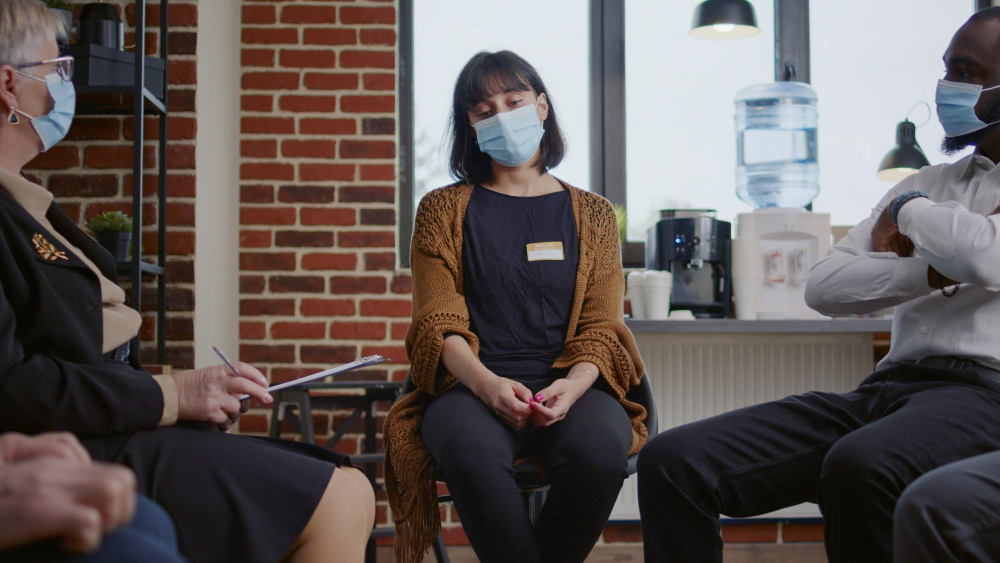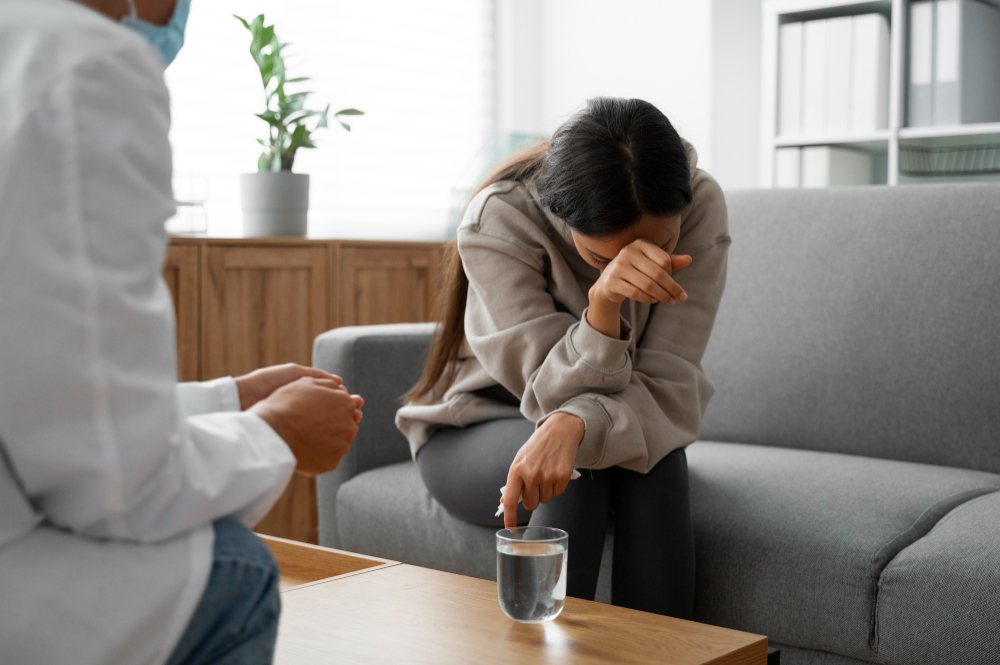4 Benefits of Opioid Addiction Treatment
July 2, 2024
Opioid addiction has been the engine behind a worldwide epidemic, preying on those struggling with pain and mental health problems and those caught in the collateral. Each year, opioid overdoses claim lives that could have been saved with the intervention of opioid addiction treatment. Medical professionals know this and have been spending decades trying to boost the message that there is help for those struggling with opioid addiction.
The Benefits of Opioid Addiction Treatment
Opioid addiction treatment offers a range of benefits for individuals struggling with addiction. From reducing overdose deaths to improving employment prospects, these treatments play a crucial role in helping individuals regain control of their lives.

Reduction in Overdose Deaths
One of the most significant benefits of opioid addiction treatment is the reduction in overdose deaths. Medication-assisted treatment (MAT), an effective approach to opioid addiction treatment, can reduce the risk of overdose death by half, according to the Centers for Disease Control and Prevention [1]. By providing medications that help manage cravings and withdrawal symptoms, MAT programs contribute to saving lives and creating a pathway to recovery.
Decreased Illicit Drug Use and Increased Treatment Retention
Opioid addiction treatment has shown success in reducing illicit drug use and increasing treatment retention rates. MAT programs, in particular, have been proven to assist individuals in reducing their illicit opioid use and staying engaged in treatment [1]. By combining medication with counseling and behavioral therapies, these programs address both the physical and psychological aspects of addiction, promoting long-term recovery.
Lower Rates of HIV and Hepatitis C Transmission
Seeking treatment for opioid addiction not only benefits the individual but also has a positive impact on public health. Opioid addiction treatment can lower rates of HIV and hepatitis C transmission by reducing needle sharing among individuals struggling with addiction. By providing access to sterile syringes and education on safer injection practices, treatment programs help prevent the spread of these bloodborne infections [1].
Improved Employment Prospects and Overall Functioning
Opioid addiction can have a significant impact on an individual's employment prospects and overall functioning. However, seeking treatment can lead to improved employment opportunities and overall functioning.
By addressing the underlying causes of addiction and providing support for recovery, treatment programs help individuals rebuild their lives and reintegrate into society. With improved physical and mental well-being, individuals are better equipped to pursue employment and achieve their personal goals.
Decreased Burden on the Criminal Justice System
Opioid addiction treatment programs also contribute to decreasing the burden on the criminal justice system. By providing support and rehabilitation options for individuals struggling with addiction, these programs offer an alternative to incarceration.
Treatment-focused approaches help address the root causes of addiction and offer individuals a chance to break free from the cycle of substance abuse. By reducing the number of individuals involved in criminal activities related to drug use, treatment programs contribute to a safer and healthier society.
The benefits of opioid addiction treatment extend beyond the individual, positively impacting public health, communities, and the overall well-being of society. By prioritizing access to effective treatment options, we can help individuals overcome addiction and pave the way for a brighter future.
Medication-Assisted Treatment for Opioid Addiction
Medication-assisted treatment (MAT) has proven to be an effective approach in treating opioid addiction, providing individuals with a path towards recovery and improved quality of life. This section explores the benefits of opioid agonist medications, such as methadone and buprenorphine, which are commonly used in medication-assisted treatment.
Effectiveness of Opioid Agonist Medications
Opioid agonist medications have shown significant effectiveness in the treatment of opioid dependence. According to the Centers for Disease Control and Prevention (CDC), MAT reduces the risk of overdose death by half. These medications help to stabilize neuronal systems and provide a narcotic blockade, leading to several positive outcomes.
Stabilizing Neuronal Systems and Narcotic Blockade
Opioid agonist medications, such as methadone and buprenorphine, play a crucial role in stabilizing the neuronal systems affected by opioid addiction. By binding to opioid receptors in the brain, these medications help to alleviate withdrawal symptoms and reduce cravings.
The narcotic blockade aspect of these medications prevents individuals from experiencing the euphoric effects of opioids. This reduces the likelihood of relapse and facilitates the process of recovery.
Reduction in Illicit Drug Use and Adverse Consequences
One of the primary benefits of opioid agonist medications is their ability to reduce illicit drug use. Studies have shown that individuals participating in MAT are more likely to decrease their use of illicit opioids, leading to improved health outcomes and reduced risks associated with illicit drug use [1].
Furthermore, MAT has been linked to decreased adverse consequences, such as the transmission of HIV and hepatitis C. By providing individuals with a reliable and regulated medication, the risk of engaging in high-risk behaviors associated with drug use decreases.
Methadone and Buprenorphine as Treatment Options
Methadone and buprenorphine are two of the main medications used in opioid agonist therapy. Methadone is a long-acting opioid agonist that blocks the euphoric effects of opioids and stabilizes psychosocial functioning. Buprenorphine, on the other hand, is a high-affinity partial agonist at the µ-opioid receptor and an antagonist at the κ-opioid receptor.
Both medications have proven efficacy in the treatment of opioid dependence. Methadone and buprenorphine reduce illicit drug use, minimize euphoria, decrease adverse consequences such as HIV infection and overdose, and alleviate opioid withdrawal symptoms [2].
To deter misuse or diversion of the medication, the combination formulation of buprenorphine/naloxone is often used. Naloxone is an opioid antagonist that counteracts the effects of opioids and serves as an additional safety measure.
In conclusion, medication-assisted treatment with opioid agonist medications, such as methadone and buprenorphine, offers a range of benefits for individuals seeking recovery from opioid addiction. These medications, combined with psychosocial support, provide a comprehensive approach to treatment, improving the chances of successful outcomes and long-term recovery.
Treatment Approaches for Opioid Addiction
When it comes to addressing opioid addiction, various treatment approaches have proven effective in helping individuals on their path to recovery. These approaches encompass self-help programs, therapy techniques, and the use of specific medications. By combining these strategies, individuals can increase their chances of overcoming addiction and maintaining abstinence.
Self-Help Programs and Group Therapy
Self-help programs, such as Narcotics Anonymous, play a crucial role in supporting individuals with opioid use disorder (OUD). These programs provide a sense of community and understanding, allowing individuals to share their experiences, challenges, and successes in a non-judgmental environment.
Group therapy, which is often a component of self-help programs, can be cost-effective compared to individualized therapy for treating OUD. It allows individuals to connect with others facing similar challenges, providing support and encouragement along the recovery journey.
Cognitive-Behavioral Therapy for Minimizing Relapses
Cognitive-Behavioral Therapy (CBT) is an evidence-based therapy technique commonly used in the treatment of opioid addiction. CBT aims to address the underlying thoughts, emotions, and behaviors that contribute to substance use.
By identifying and challenging negative patterns and developing healthier coping strategies, CBT helps individuals minimize the risk of relapse. This therapy approach equips individuals with the skills and tools necessary to manage cravings, cope with stress, and make positive choices that support long-term recovery.
Use of Opioid Antagonists for Maintaining Abstinence
Opioid antagonists, such as naltrexone, are medications used to maintain abstinence from opioids in individuals with OUD. Naltrexone works by blocking the effects of opioids in the brain, reducing cravings and the risk of relapse. It can be administered orally or through a monthly intramuscular injection, offering flexibility and convenience for individuals in treatment. Intramuscular naltrexone may be particularly beneficial for those who struggle with medication compliance.
Role of Naltrexone in Opioid Addiction Treatment
Naltrexone plays a significant role in opioid addiction treatment by providing an additional layer of support for individuals in recovery. By blocking the effects of opioids, naltrexone helps individuals maintain abstinence and reduce the risk of overdose.
It is especially useful for individuals who have completed detoxification and are committed to their recovery journey. Naltrexone can be a valuable tool in combination with therapy and support programs to help individuals break free from the grip of opioid addiction.
By utilizing a combination of self-help programs, therapy techniques, and medication-assisted treatment, individuals with opioid addiction can access comprehensive and holistic support on their path to recovery. It's important to remember that treatment approaches should be tailored to meet each individual's specific needs and preferences. With the right combination of strategies and support, individuals can regain control of their lives and find hope in overcoming opioid addiction.
Global Impact of Opioid Addiction
Opioid addiction is a significant global issue with profound consequences for individuals and societies. Understanding the global impact of opioid addiction is crucial in addressing this public health crisis.
Prevalence of Opioid Use Disorder Worldwide
The prevalence of opioid use disorder (OUD) is alarmingly high worldwide. It is estimated that there are approximately 15.6 million illicit opioid users globally, with 11 million primarily using heroin [2]. In the United States alone, over 2.1 million individuals are affected by OUD. These numbers highlight the magnitude of the problem and the urgent need for effective treatment options.
Economic Burden and Health Consequences
The economic burden of opioid dependence is extensive, resulting in significant healthcare costs, lost productivity, and other adverse consequences. The transmission of HIV and hepatitis C is a major concern, as opioid injection drug use is a key driver of these infections. Additionally, the healthcare system faces substantial challenges in managing the physical and mental health consequences of opioid addiction.
Long-Term Pharmacological Maintenance Treatment
To address the global impact of opioid addiction, long-term pharmacological maintenance treatment has emerged as an effective approach. This treatment involves the use of medications to reduce withdrawal symptoms, cravings, and the risk of relapse. Methadone and buprenorphine are two medications commonly used in opioid replacement therapy.
Methadone and Buprenorphine in Opioid Replacement Therapy
Methadone and buprenorphine have proven to be effective in reducing illicit drug use, overdose deaths, and criminal behavior among individuals with opioid addiction.
These medications act by binding to the same opioid receptors in the brain, providing a controlled and safer alternative to the use of illicit opioids. By stabilizing the neuronal systems and blocking the effects of other narcotics, methadone and buprenorphine help individuals overcome the challenges of addiction and improve their overall well-being.
When used as part of a comprehensive treatment program, methadone and buprenorphine have shown positive outcomes, including decreased illicit drug use, improved treatment retention, and reduced adverse consequences associated with opioid addiction.
The global impact of opioid addiction necessitates a multifaceted approach involving treatment, prevention, and harm reduction strategies. By implementing evidence-based practices and providing access to comprehensive addiction treatment services, we can strive to mitigate the devastating effects of opioid addiction on individuals, families, and communities worldwide.
Opioid Addiction Treatment Resources
Accessing the right support services and resources is crucial for individuals seeking help with opioid addiction. In Canada, there is a range of resources available to provide assistance and support. These include support services, access to naloxone for overdose prevention, helplines and communication channels, online support groups and tools for recovery, as well as support specifically tailored for parents and frontline workers.
Support Services and Resources in Canada
In Canada, individuals seeking help with opioid addiction can find a wide range of support services and resources. These services are designed to provide assistance and guidance to anyone in need, regardless of their location or circumstances. Services and resources may include counseling, therapy, peer support, and access to treatment programs. These resources aim to empower individuals to overcome addiction and lead healthier lives [4].
Access to Naloxone for Overdose Prevention
Naloxone is a medication used to reverse opioid overdoses and save lives. In Canada, access to naloxone is an essential part of the opioid addiction treatment resources. Naloxone distribution sites are available through various channels, including pharmacies and harm reduction centers.
These sites provide naloxone kits and training on how to administer the medication in case of an overdose emergency. The availability of naloxone plays a critical role in preventing fatal overdoses and providing immediate assistance to those in need.
Helplines and Communication Channels
For individuals seeking immediate support or information, various helplines and communication channels are available. These resources provide accessible and confidential assistance to individuals struggling with opioid addiction.
Helplines may offer phone, text, email, or chat services, catering to different communication preferences. Dedicated helplines are often available for specific groups, such as youth, adults, and frontline workers. These helplines connect individuals with trained professionals who can provide guidance, information, and referrals to appropriate services [4].
Online Support Groups and Tools for Recovery
The digital landscape offers valuable resources for individuals seeking support and recovery from opioid addiction. Online support groups provide a platform for individuals to connect, share experiences, and receive encouragement from others who have gone through similar challenges.
Additionally, various tools and resources are available online to aid in recovery, including self-help materials, text messaging services, and access to the Naloxone Finder program. These online resources complement traditional treatment approaches by providing additional support and information [4].
Support for Parents and Frontline Workers
Opioid addiction not only affects individuals directly struggling with addiction but also has an impact on their families and frontline workers. Support services in Canada recognize the importance of providing assistance to these groups. Parent-to-parent support programs offer guidance and understanding to parents dealing with the challenges of having a child with opioid addiction.
Additionally, dedicated support services are available for frontline workers, equipping them with the necessary resources and support to address the complex needs of individuals affected by opioid addiction. Provincial and territorial health and support services further contribute to the comprehensive network of resources available to support those impacted by opioid addiction.
By utilizing the support services and resources available in Canada, individuals struggling with opioid addiction can access the necessary assistance to navigate their recovery journey. Whether through helplines, online support groups, or specific resources for parents and frontline workers, these resources aim to provide the guidance and support needed for individuals to regain control of their lives and embark on a path to recovery.
References
[1]: https://www.cdc.gov/drugoverdose/featured-topics/treatment-recovery.html
[2]: https://www.ncbi.nlm.nih.gov/pmc/articles/PMC3701303/
[3]: https://www.ncbi.nlm.nih.gov/books/NBK553166/
[4]: https://www.canada.ca/en/health-canada/services/substance-use/get-help-with-substance-use.html
Consider Clear Steps Recovery for Opioid Treatment in New Hampshire
The benefits of opioid addiction treatment are numerous and substantial. Recovering on one’s own might seem bold and like a sign of selflessness, but it couldn’t be further from the truth. Put your trust in the trained specialists at Clear Steps, and allow us to make recovery as safe and comfortable as possible.
If you believe someone you know and love has a dependency on opioids, it can be hard to distinguish the signs for sure. The best choice is to ask questions and get answers, both of which are ready options at Clear Steps Recovery. It’s a complicated set of circumstances to decide what treatment is best for your situation, but don’t worry—our team has years of experience and a history of solutions. We can aid in the entire process; just start by calling 603.769.8981 or by reaching Clear Steps Recovery online.
Learn About Clear Steps Recovery and How We Can Help You
Once you reach out to Clear Steps Recovery, your path becomes clear, and you can get the help and support you need to break the cycle of addiction. Our serene woodland environment promotes physical, mental, emotional, and spiritual healing.
Call today or contact us online to get started.
The Path Is Clear – Take Your First Steps Today with Clear Steps Recovery
With our team and your desire to heal, we can improve your quality of life and functional abilities, so you can get back to living your best life.
































.jpg)


















.jpg)
.jpg)















































